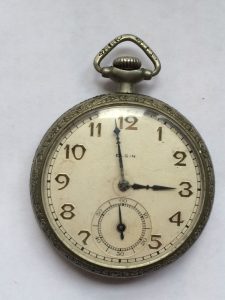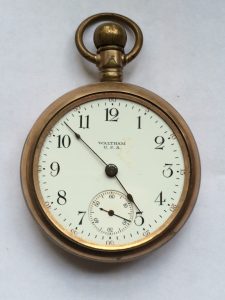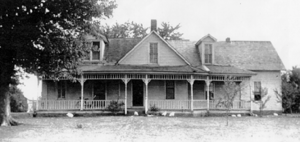Trying To Place A Value On Memories
For 68 years I have saved a little red leather box.
That little box has survived each of our sixteen moves, and always found it’s way to a safe drawer where, surprisingly, I always knew where it was, but rarely opened it.
But not long ago, a friend mentioned that he was having an old pocket watch he owned restored, and that got me thinking about whether I should do the same thing to the two pocket watches in my little red box.
A Trip to the Jewelry Store
I laid the two pocket watches on the counter and matter-of-factly said to the watch expert, “I have these two pocket watches and wonder if it would be worthwhile to have them restored? What do you think?”
The expert turned the winding knobs, looked the watches over real good, and, with the true air of someone who knows what he is doing, said, “Well, it would cost you more to fix these up than they would be worth.”
“I wouldn’t mess with ‘em. Pocket watches like these are a “dime a dozen.”
Driving Home
Reality set in as I drove home from the jewelry store.
The more I thought about what the watch expert had said, and the more I thought more about my watches, the angrier I got.
A dime a dozen indeed! He didn’t really know anything about my watches, and somehow I had ignored what I knew about them too.
It was on that ride home that I began to realize how valuable my watches really are.
The Value of the Watches
If you guessed this from the very beginning, you were right.
The silver-colored (Silver) watch belonged to my grandfather, Edmon Odaffer (1865-1945), and the gold-colored watch (Gold) belonged to my father, Ray Odaffer(1900-1950).
I don’t know where my father and grandfather bought their watches, but I bet a dollar it was from the Sears-Roebuck catalog.
(Richard Sears started a company that sold pocket watches through mail order catalogs in 1888, and a few years later he and Alvah Roebuck, renamed their expanded watch company Sears, Roebuck & Company.)
But the real value of the watches is what they symbolize, and the memories they invoke in me. I’d like to take a moment to explain this.
My Grandfather Edmon and His Watch
Edmon was a successful farmer. He knew how to do it, and he taught his only son, my father Ray O’Daffer, to do it, too.
And he was very proud of “the home place” where he had moved and fixed up a good country house for his family to live in.
When it came time for him to quit farming and turn it over to my dad, Ed did what a lot of farmers dream about doing when they retire–he moved to town!
In town, Ed developed a ritual based on who he thought he was–an important successful, retired farmer who had made something of his life.
Every day, Monday through Friday, Ed would get up around 7 a.m. (awfully late, in the mind of an old farmer), and enlist my grandmother Mattie to help him get ready. She would bring him a freshly washed and ironed white shirt, a necktie, and his one and only good black suit.
Then Ed polished and wound his silver pocket watch, attached the watch fob, and carefully placed it his suit watch pocket.
Ed, with a reputation for being a little hyper and a quick mover, would twist his mustache several times, check his watch again, and take off.
Ed would walk several blocks to Main Street in Weldon, Ill., and take his place on a bench in front of the Post Office–where he stayed until time for dinner (12 noon, in those days).
Some others on the bench may have thought Ed was a little kooky, but it did not deter him. He was as regular in going there as his prized silver pocket watch was in giving the time.
As I look back on this, perhaps the silver pocket watch is a symbol of my grandpa Ed’s life. He was a man who made good use of his time on earth, always gave his family and grandkids the time of day, was always on time for appointments, and was proud of himself and what he did and the legacy he left for his descendants.
My Father Ray and His Watch
Ray, following in Ed’s footsteps was also a good farmer. He was also a school board member and sold seed corn for a while.
He liked his gold pocket watch and carried it in the watch pocket in his overalls.
I remember many time watching him take out the watch and check the time—whether it was in the field deciding when to come for dinner, determining when to stop running the trap line with me so he could get me to school on time, or checking to see if it was time to tune in the “Lone Ranger” for us to listen to on the battery radio.
Ray greatly enjoyed his family, and checked his prized watch to see if the plane was on time when he met his first granddaughter baby, who had flown in from California.
Like his father Ed, Ray bought a house in the country and moved it to town—remodeling it for he and my mother Ruby to live in when they retired. He was looking forward to a rewarding retirement.
Sadly, my father Ray would not be able to retire and use the house, because he was killed in a farm accident on March 23, 1950, when he was 49 years old.
He got caught in a post-hole digger that was attached to the back of our Allis Chalmers tractor and was crushed. A terrible life-changing accident—for all of us.
As usual, on the day of his accident, his gold pocket watch was in his pocket.
If you look at the watch carefully, you can see that the front plastic face cover is missing, and there is a small dent on the back—perhaps evidence that the accident took a toll on the watch too.
So, as I look back on it, the gold watch is the symbol of my father’s golden life for 50 years, and for all the time and help he gave to our family and to me when I was growing up. It also symbolizes the special times in which he really enjoyed his shortened life, like the trip to the airport.
The Moral of This Watch Story
Instead of being worth “a dime a dozen,” my watches, because of the memories they evoke, are very valuable and precious. I wouldn’t sell them for any amount of money.
So maybe we should stop taking our antiques to the “Antiques Road Show” to be evaluated.
Rather, we should take time to think hard about the memories they evoke, what they symbolize, and determine their true value ourselves.









Eric O'Daffer
Nice blog on value of memories, Dad. I love that red leather box — always has cool stuff in it. Love, Eric
stacy o'daffer
This is lovely! And, it is a perfect reminder of the very insightful phrase, “the most valuable thing we have is time.” Thank you for sharing your story so eloquently.